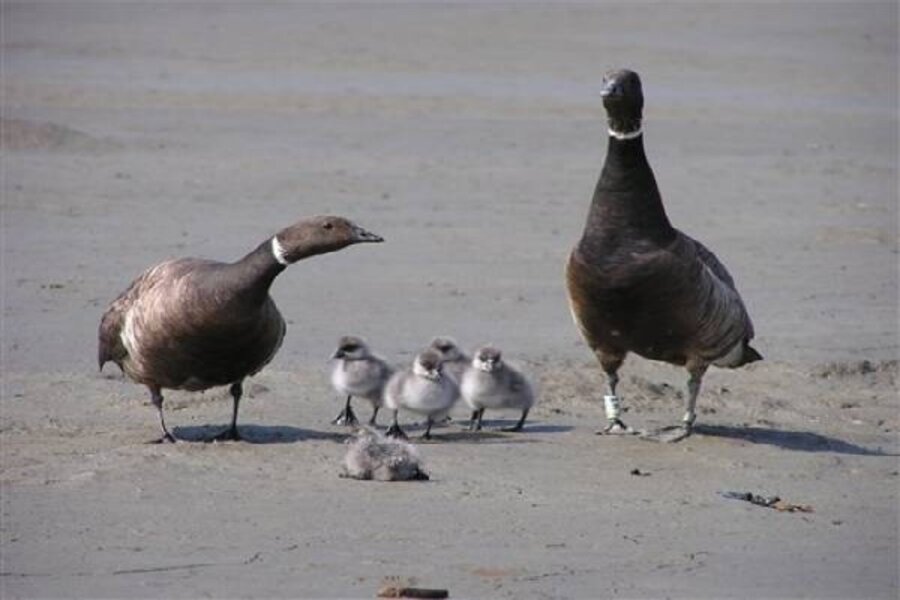Warmer Alaska winters let geese skip trip south
Loading...
| ANCHORAGE, ALASKA
A small Pacific sea goose is finding Alaska winters more to its liking, and a federal study suggests it's due to climate change.
Until recently, 90 percent of the Pacific brant population wintered in Mexico. A US Geological Survey (USGS) study found that up to 30 percent of the geese now forgo warmer regions of the Pacific coast to spend winters in snowy, icy Alaska, trading a long migration for an abundance of food formerly unavailable because it was covered with coastal sea ice.
"It's a general trend that's occurring in the northern hemisphere anyway, that birds are moving north, shifting their distributions," says lead author David Ward of the USGS Alaska Science Center. "In this case, it was a shift in winter distribution."
Brant are herbivores. The shift appears related to changes in the availability of eelgrass, which grows in shallow bays and coves and is their primary food when not breeding. Higher air and water temperatures have reduced Alaska coastal sea ice and made eelgrass accessible for more winter days.
A previous study indicated brant could spend fat reserves on migration or an Alaska winter as long as they had undisturbed access to sufficient amounts of eelgrass, Ward says. That may not have been the case a few decades ago.
Fewer than 3,000 brant were detected wintering in Alaska before 1977. That has jumped to as many as 40,000 birds.
The study looked at brant numbers from the mid-1960s to 2005. Researchers looked at brant numbers collected in annual Christmas bird counts plus federal waterfowl surveys that started in the 1980s. Data collected after 2005 corroborate the trend, Ward says. Alaska now has the second-highest winter concentration of brant after Mexico.
The Alaska brant are mostly found in Izembeck Lagoon and adjacent bays on the Alaska Peninsula, the 500-mile tongue of mainland that juts toward the Aleutian Islands.
Mean surface air temperature during winter at the end of the Alaska Peninsula increased about 1 degree Celsius between 1963 and 2004. That resulted in a 23 percent reduction in freezing degree days and a 34 percent decline in the number of days when ice kept brant from eelgrass.
Conditions on the peninsula are fairly harsh, Ward says. A cold snap in the wet conditions can ice up a brant's wings, preventing it from flying.
There are benefits, however, to the birds' sitting out a flight of up to 3,500 miles to Baja California, Mexico, which they sometimes do nonstop. Eelgrass in northern latitudes has higher protein value. The geese stay closer to breeding grounds in Alaska and can gauge weather and time breeding to the disappearance of snow. Goslings hatched early in Arctic "green-up" have a better chance at survival.
"These birds grow faster, they grow bigger, stronger, and they have higher survival than birds that come late to the breeding grounds," Ward says.
Another climate factor probably figures in the migration decision, Ward says. Low-pressure systems that sent storms sweeping across the Gulf of Alaska have moved north. The storms provided a kick-start to brant migration in the form of a tail wind.
"The birds have fewer times that they can get these tail winds," Ward says.
Wintering in Alaska comes with risk, however. A sudden, severe cold snap could put a significant portion of the brant population in danger.
During freeze-ups around Izembek Lagoon, the birds can find smaller feeding areas on nearby islands or perhaps the west side of Kodiak. But after that, it's a 1,200-mile flight to food in British Columbia's Queen Charlotte Islands.
"In those conditions, if an ice period is long enough, it could have an effect on survival," Ward says. "We don't have any data to indicate one way or another."
Editor’s note: For more articles about the environment, see the Monitor’s main environment page, which offers information on many environment topics. Also, check out our Bright Green blog archive and our RSS feed.





